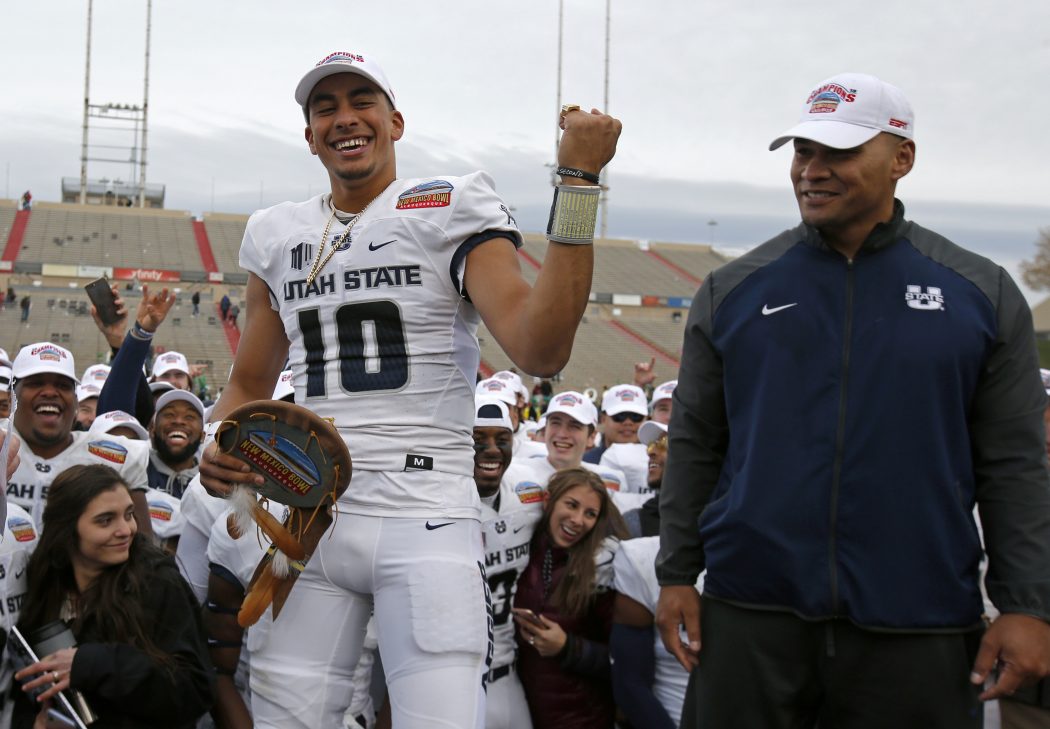The complete Utah State bowl game history
So last year a near exact version of the ensuing article was released. But it’s been a year since then so not only does it need an update, but you may have forgotten since then or not had the pleasure of reading it. So here we go.
Officially, Utah State has appeared in 12 bowl games. According to the USU athletic department, that number is 13. The reason for the discrepancy in these numbers is because one of the bowls the Aggies played in, the 1947 Grape Bowl, was not an NCAA sanctioned game even though the results appear in NCAA records.
The 12 appearances is tied with four other teams for 84th-most among all NCAA teams. It ranks third in the state of Utah behind, guess who, the University of Utah (T-52nd, 22 games) and BYU (T-25th, 36 games). USU’s record in postseason games, 5-7 (.417), has actually moved up among these three teams. They’re now tied in winning percentage with BYU’s 15-20-1 record (.417). Utah is still the only team with a winning bowl record in the state with a 17-4 (.810) mark.
When compared to the rest of the Mountain West Conference, things aren’t the greatest. USU is tied for ninth (with Hawai’i) in total bowl appearances, though they moved up from 10th last year to eighth this year.
So, in other words, the Aggies are historically below-average at bowling relative to the NCAA and the state of Utah itself.
That trend is quickly reversing itself, though. Since 2011, the Aggies have made it to a bowl game eight times including this season. That number is more than the Utes (six) and is tied with BYU. The Cougars and Aggies have identical records in those games at 4-3 (Utah is 5-1 in that span).
That said, bask in the glory of Utah State’s 13 official and unofficial bowl games.
Raisin Bowl (1946)
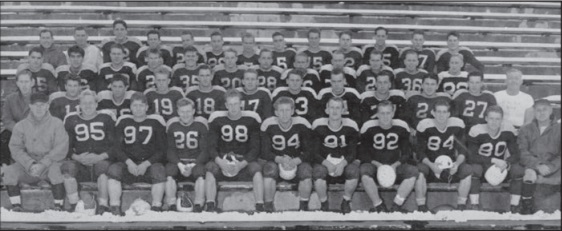 Utah State Athletics
Utah State Athletics Jan. 1, 1947
Ratcliffe Stadium (Fresno, CA)
Utah State (7-1-1) — 0
San Jose State (8-1) — 20
The first-ever bowl game in program history came before the school was even a university. It would be 10 years until Utah State Agricultural College would become Utah State University. But under head coach E. Lowell Romney, these beta-Aggies pulled together a 7-1-1 record in the regular season and were invited to the Raisin Bowl.
The game itself was played on New Year’s Day (in other words, it was a New Year’s Six bowl game). It was the second edition of the bowl series that would only last until 1949 with just five games played.
Unfortunately, things did not go well for Utah State in their first attempt at bowling. In front of a crowd of roughly 13,000 people, the Spartans shut out the Aggies while scoring three touchdowns. Utah State made it to the San Jose State one-yard line on two different occasions but were stonewalled on each occasion.
Grape Bowl (1947)
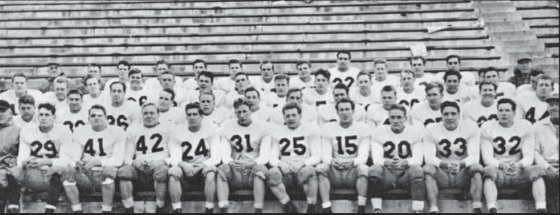 Jason Walker
Jason Walker Dec. 13, 1947
Grape Bowl Stadium (Lodi, CA)
Utah State (6-4) — 21
Pacific (8-1) — 35
This game is the aforementioned contest that counts but also doesn’t count as a bowl game. Again, the results and stats show up in the annuls of the NCAA but aren’t reflected either team’s overall bowl record.
Perhaps that is for the best as, just like the previous year, going to a bowl game didn’t end well for Utah State. The team maintained much of its success from the previous season but failed to show up in a significant way in the postseason.
Pacific put a beat-down on the still yet-to-be university. The Tigers outscored Utah State 28-0 in the first half and were up 35-7 in the third quarter. Just like in the first bowl game, the Aggies had trouble when on the opponent’s one-yard line. On the first drive of the game, running back John Worley fumbled the ball on the goal line and it was returned 99 yards by the Tigers to give them a 14-0 lead.
Because this game wasn’t an NCAA bowl game, Pacific actually went on to play in a second bowl game in the same season. They beat Wichita in the Raisin Bowl on Jan. 1, just 18 days after beating the Aggies to crack the 10-win mark.
Sun Bowl (1960)
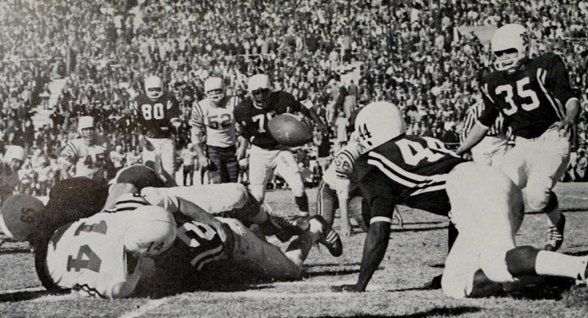
Dec. 31, 1960
Sun Bowl (El Paso, TX)
Utah State (9-1) — 13
New Mexico State (10-0) — 20
Remember two years ago when USU played New Mexico State in a bowl game and people would talk about how long it had been since NMSU had played in a bowl game? This was that “last bowl game” they played in before 2017.
It was the first-ever meeting for the two Aggie schools (the first of now 39 matchups) and it was the southern Aggies that won the day, completing a perfect 11-0 season under future College Football Hall of Fame head coach Warren Woodson.
Even though New Mexico State had the leading rusher in college football, Bob Gaiters, Utah State out-rushed their foe 268-44. However, the eventual MVP of the game, NMSU quarterback Charley Johnson, threw two touchdown passes as New Mexico State had 190 passing yards to USU’s zero.
This was the first bowl Utah State has played in that is still played today.
Gotham Bowl (1961)
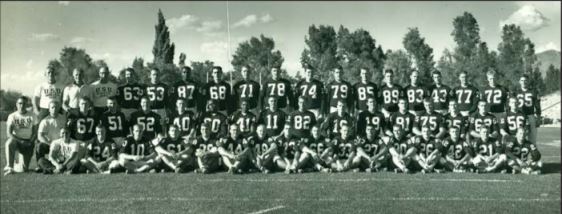 Utah State Athletics
Utah State Athletics Dec. 9, 1961
Polo Grounds (New York, NY)
Utah State (9-0-1) — 9
Baylor (5-5) — 24
Yes, Utah State has played in a bowl game called the Gotham Bowl and no, it had nothing to do with Batman sadly.
The Gotham Bowl was short-lived with only three active years and two games played. The Aggies technically played in the inaugural game but only because the year before, the game organizers were unable to find an opponent for the one team that accepted the invitation: Oregon State.
During the 1961 season, the Aggies managed to get themselves ranked in the AP top 25 for the second year in a row. They managed to climb all the way to No. 10, the only time in program history USU has been inside the top 10 in an AP poll.
In the bowl game, the Aggies committed seven turnovers — four fumbles lost and three interceptions — which the Bears turned into three touchdowns and a field goal. Those turnovers doomed the USU offense which had otherwise been able to move the ball fairly well.
Had Utah State managed to beat Baylor, they would have gone undefeated for the third time in school history — the first since 1936 — and reached 10 wins in a season for the first time ever. Instead, it would be 51 years before the Aggies would eclipse 10 wins in a season.
This season was the second time Utah State made it two a bowl game in back-to-back years. But it was after this season that the Skyline Conference dissolved, and the Aggies went independent until 1978.
Las Vegas Bowl (1993)
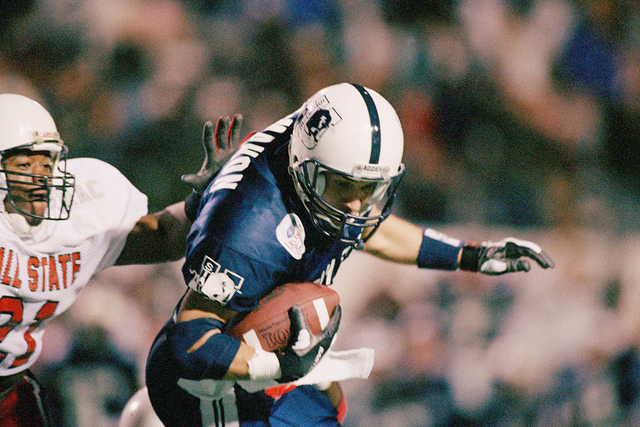
Dec. 17, 1993
Sam Boyd Silver Bowl (Las Vegas, NV)
Utah State (6-5) — 42
Ball State (8-3) — 33
In the second-ever Las Vegas Bowl, the Aggies finally got its first postseason victory, though it nearly didn’t make it there in the first place.
Six weeks into the season, Utah State found themselves at 1-5 but with the help of quarterback Anthony Calvillo, the team won its remaining five regular season games and qualified for a bowl game with its first winning season in 13 years. During this season, Calvillo set single-season USU records for pass completions (247), pass attempts (469), total offense (3,260) and came 70 yards away from the passing record. The attempts record still stands today.
The Aggies opened a 21-0 lead at halftime and withstood a spirited comeback by the Cardinals. Calvillo, whose backup was former USU head coach Matt Wells, completed 25 passes (of 39 attempts) for 286 yards and three touchdowns. All three of those marks were records at the time though the completions is the only one that still stands.
Calvillo wasn’t the only one who had a good day. Sophomore running back Profail Grier ran the ball 32 times —also a current USU bowl record — for 143 yards and two touchdowns.
Humanitarian Bowl (1997)
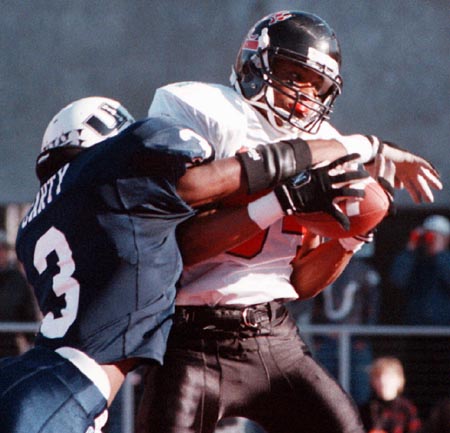
Dec. 29, 1997
Bronco Stadium (Boise, ID)
Utah State (6-5) — 19
Cincinnati (7-4) — 35
Utah State went into the first edition of the Humanitarian Bowl knowing it would be the last game for head coach John L. Smith. The third-year coach had accepted the top job at Louisville after helping the Aggies get back-to-back six win seasons for the first time in 15 years.
This season is also the most recent year that Utah State was the only team from the state of Utah to make a bowl game. Unfortunately, the Aggies didn’t represent very well.
The Bears controlled the game from the opening whistle and led 35-7 with 2:28 to go in the third quarter. USU went on to score a pair of touchdowns (missing a PAT and then failing on a two-point conversion) to make the game appear closer than it actually was.
Senior wide receiver Steve Smith was the top performer for the Aggies. He caught four passes for 136 yards and a touchdown (a 75-yard score). Fellow senior and quarterback Matt Sauk completed only 12 of his 30 pass attempts, but finished with 253 yards and one passing TD. His yards per completion (21.1) remains Utah State bowl record.
Potato Bowl (2011)
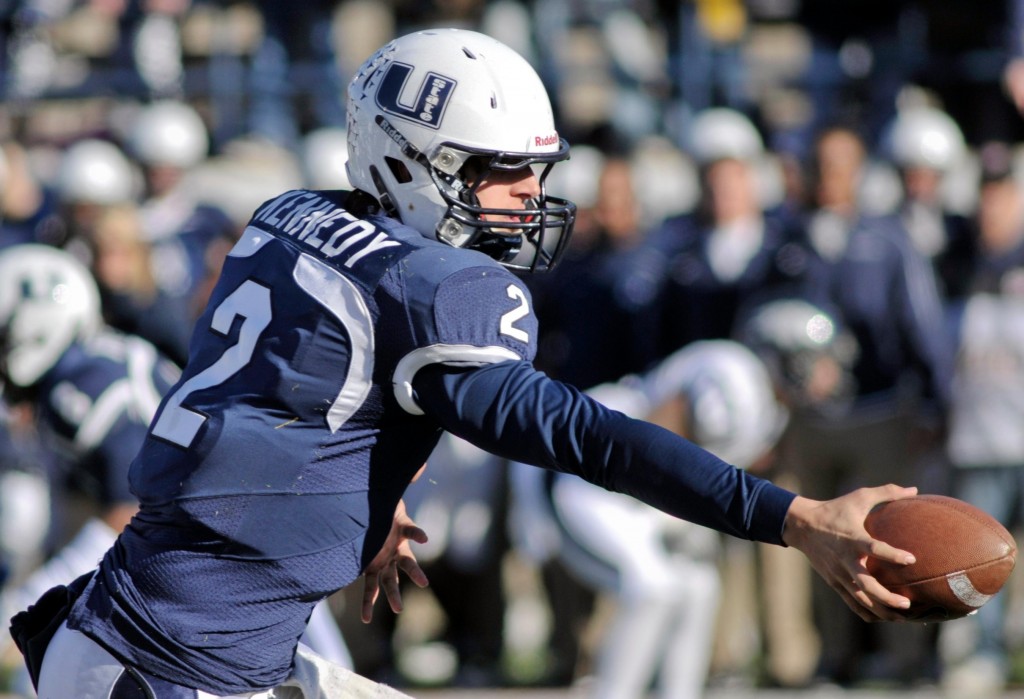 Cody Gonchnour
Cody Gonchnour Photo by Cody Gonchnour
Dec. 17, 2011
Bronco Stadium (Boise, ID)
Utah State (7-5) — 23
Ohio (9-4) — 24
Fourteen years after playing in the Humanitarian Bowl, the Aggies returned to Bronco Stadium for a postseason game, ending the program’s second-worst bowl drought in history (14 years, the program record is 32 years). In that time, the bowl game itself had undergone three name changes, having just been renamed the Potato Bowl following the 2010 season after stints as the Humanitarian Bowl (1997-2003), MPC Computers Bowl (2004-06) and again the Humanitarian Bowl (2007-10).
The Aggies held a 23-10 lead late in the third quarter, but Ohio managed to cut the lead down to 23-17 with 3:45 in the third. And with 13 seconds left in the game, Tyler Tettleton scored the game-winning touchdown for the Bobcats.
This game was the finale to Robert Turbin’s storied Utah State career. He had rushed for school-record 19 touchdowns and would end the season with 1,517 rushing yards, third-best in program history.
Turbin had a solid game with 101 yards, but it was fellow senior running back Michael Smith who topped the USU offense in yards. Smith ran for a then-USU bowl record and career-high 157 yards and two touchdowns. That effort got Smith the co-MVP award of the game, despite the loss, with Ohio wide receiver Lavon Brazill (8 catches, 108 yards, one TD).
Potato Bowl (2012)
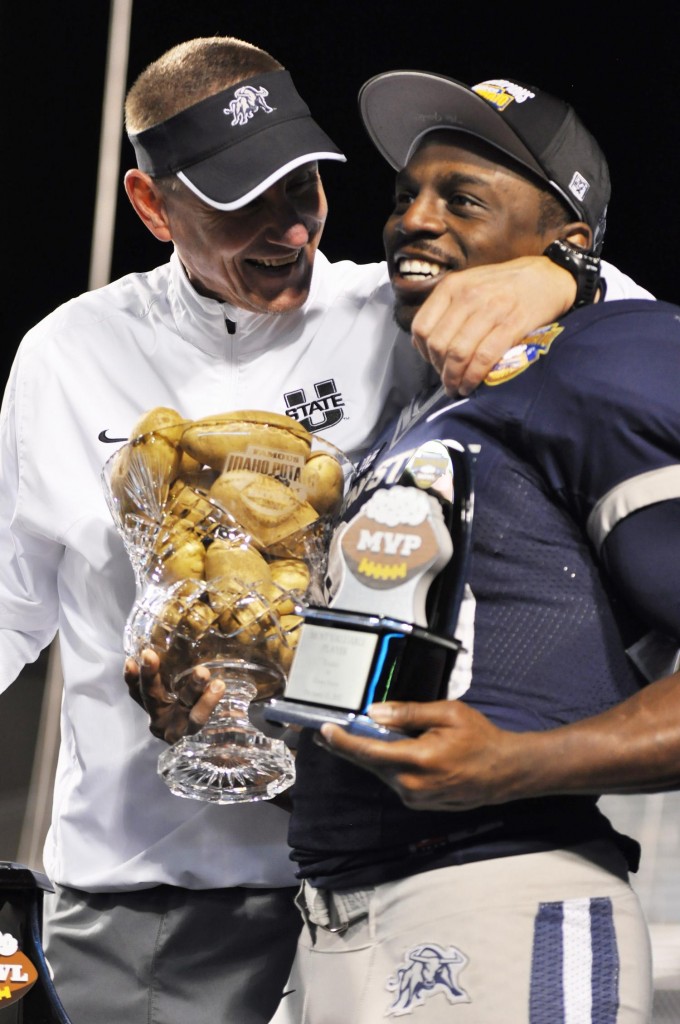
Delayne Locke photo
Dec. 15, 2012
Bronco Stadium (Boise, ID)
Utah State (10-2) — 41
Toledo (9-3) — 15
Many times, Utah State found itself on the wrong end of a bowl-game blowout. In 2012, the Aggies turned that around by demolishing Toledo to complete the greatest football season in Utah State University history.
The game itself turned out to be close for three quarters. Entering the fourth quarter, Utah State only led 13-6; and with just 7:28 left in the game, Toledo had cut that down to 13-9. That’s when the two-headed dragon of quarterback Chuckie Keeton and running back Kerwynn Williams took over.
In less than six minutes of game time after Toledo drew within four points, the Aggies scored four touchdowns. Williams was responsible for three of those scores. When the final whistle finally blew, Williams and Keeton had combined for more rushing yards (327) than Toledo had total yards (315).
Williams ran for 235 yards — still a USU bowl record — on just 18 carries and Keeton had 92 on only nine rushes. In all, Utah State averaged 11.4 yards per rush (31 rushes, 353 yards) which is an NCAA bowl game record (minimum 30 attempts).
Toledo failed to reach the end zone on offense, only scoring six on an 87-yard kick return in the fourth quarter after Williams’ third touchdown.
Poinsettia Bowl (2013)
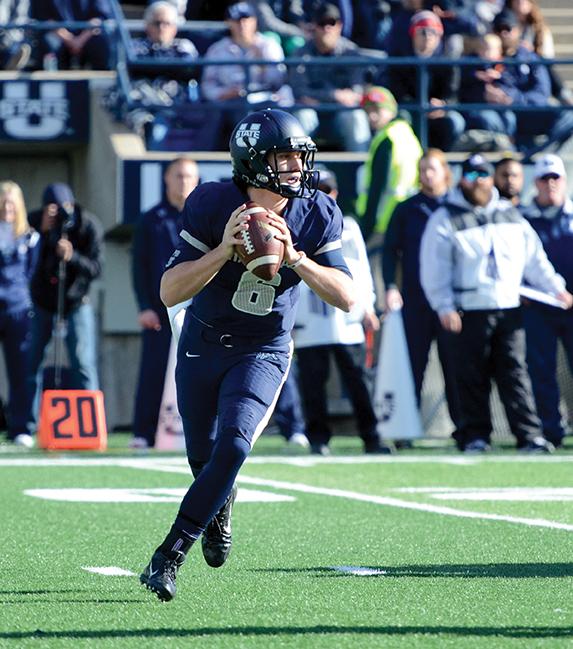 DeLayne Ripplinger
DeLayne Ripplinger Dec. 26, 2013
Qualcomm Stadium (San Diego, CA)
Utah State (8-5) — 21
Northern Illinois (12-1) — 14
After suffering a disappointing 24-17 loss in the MWC Championship Game to No. 24 Fresno State in Matt Wells’ inaugural season as head coach, the Aggies faced a similarly difficult challenge, getting matched up with the new 24th ranked team, Northern Illinois, in their bowl game..
NIU senior quarterback Jordan Lynch, who finished third in Heisman voting in 2013, came into the game needing 119 rushing yards to become the first-ever FBS quarterback to throw and run for 2,000 yards in a single season. Utah State’s defense proved to be up to the task, holding the Heisman candidate to just 39 yards rushing, well below his incoming average of 144.7.
The game’s leading rusher wound up being USU senior running back Joey DeMartino. The Offensive Most Valuable Player recipient ran the ball 23 times for 143 yards and a fourth quarter touchdown that ended up being the difference in the game.
Freshman quarterback Darell Garretson — the first freshman to start a bowl game at QB for the Aggies — threw for 121 yards, a touchdown and two interceptions. He also completed a two-point conversion to JoJo Natson following DeMartino’s touchdown that put Utah State up 21-7.
New Mexico Bowl (2014)
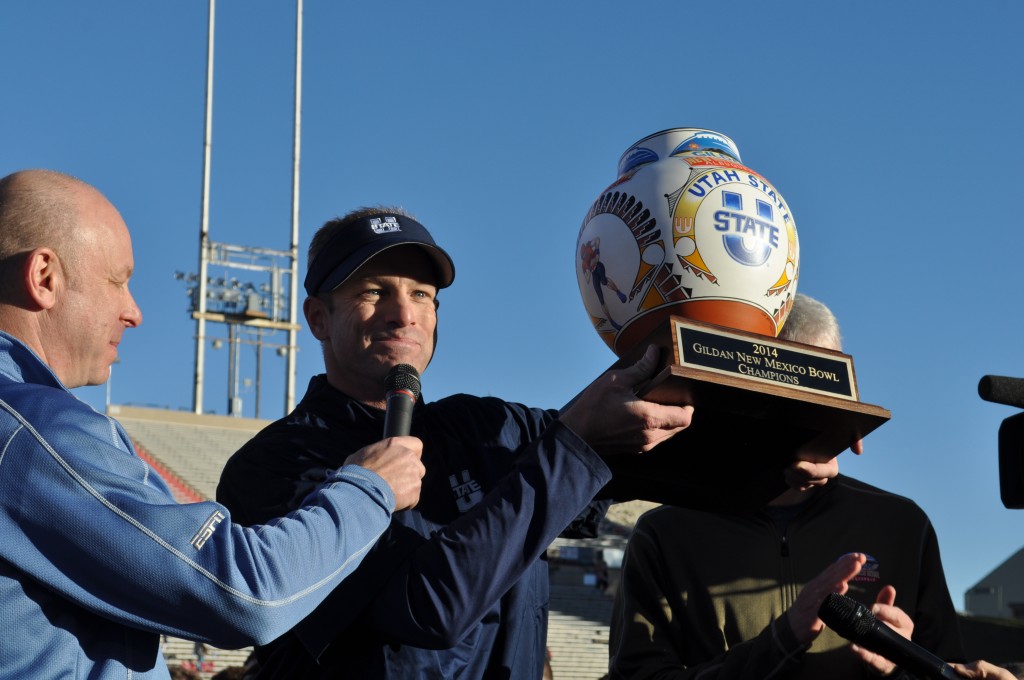
Dec. 20, 2014
University Stadium (Albuquerque, NM)
Utah State (9-4) — 21
UTEP (7-5) — 6
For the second straight year, the Aggies started a freshman in their bowl game. This time, Kent Myers was the name called upon. And despite throwing for just 68 yards on 5 of 12 passing, the freshman was named Offensive MVP thanks to his 79 rushing yards which included a 48-yard TD scamper.
Three Aggies rushed for at least 50 yards and five players reached 30 yards. Along with Myers’ team-leading 79, Ronald Butler had 69 yards (61 coming on one play), Joe Hill had 50 on six carries, JoJo Natson ran five time for 40 yards and Nick Vigil had 34 yards, including a three-yard touchdown.
Defensive MVP Zach Vigil (11 tackles, 1.0 for loss, one pass breakup and one QB hurry) led a dominant team performance that kept UTEP out of the end zone the entire night. Utah State allowed just 275 yards of total offense (3.9 yards per play), even with the Miners’ holding the ball 13 more minutes of game time than the Aggies.
This win made it three straight bowl wins, which still stands as a program record.
Potato Bowl (2015)
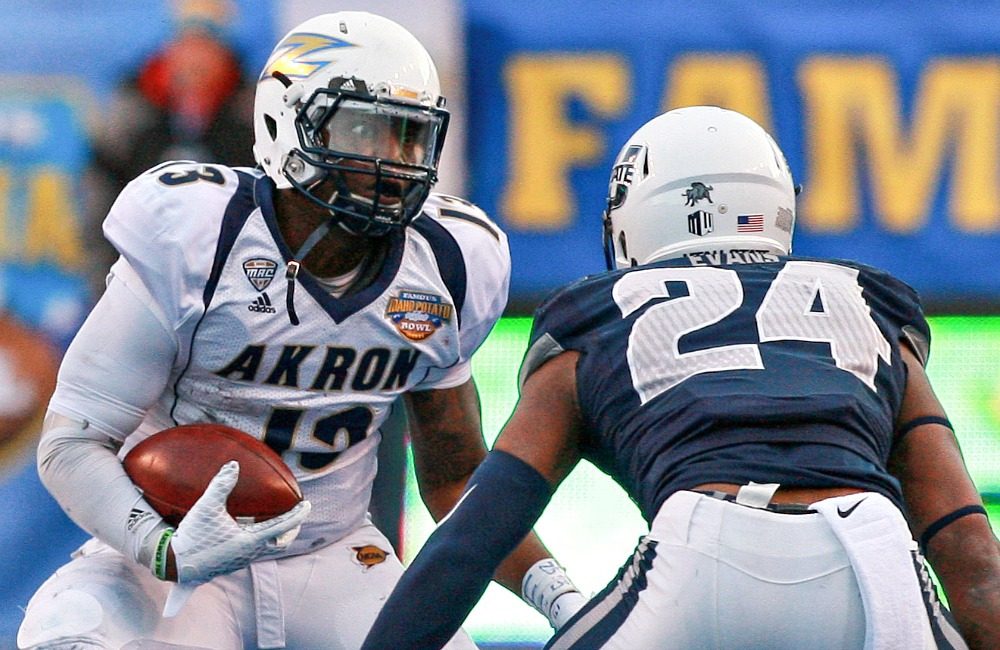 College Football News
College Football News Dec. 22, 2015
Albertsons Stadium (Boise, ID)
Utah State (6-6) — 21
Akron (7-5) — 23
This game extended a program record of consecutive bowl games to five and was Chuckie Keeton’s final game as an Aggie. And it ended in defeat, giving Akron its first-ever bowl victory.
It was also the final game for linebackers Nick Vigil and Kyrel Fackrell who entered the game with a combined 216 tackles, 26.0 for loss, 7.0 sacks, four forced fumbles and 16 QB hurries on the year. Those two defensive studs held the Zips to 100 yards rushing on 42 attempts (2.4 per attempt).
The offense couldn’t take advantage of the defense’s solid game, however. Despite out-gaining Akron 368-282, USU failed to convert, bungling away chance after chance with three turnovers and other key mistakes.
Twice in the first half when they reached the red zone, Utah State came up empty. First, Keeton overthrew TE Wyatt Houston and was intercepted on the six-yard line. Shortly after on a 35-yard field goal attempt, then-freshman D.J. Nelson mishandled the snap and was tackled for a seven-yard loss. In all, USU had four turnovers in the game, including the turnover on downs resulting from the failed field goal.
Keeton wasn’t the only USU quarterback to play significant snaps, however. Sophomore Kent Myers played in the second and third quarter, attempting almost as many passes as Keeton (20 compared to 22 for the senior) and getting more yards (123 to 114).
Akron eventually managed 13 first-half points to take a 13-7 lead at halftime. Utah State took a 14-13 lead on a 19-yard TD throw from Myers to Hunter Sharp with 12:41 left in the third. The Aggies wouldn’t score again until Keeton threw a two-yard touchdown to Brandon Swindall. Meanwhile, the Zips had scored another 10 points which gave them the eventual 23-21 advantage.
The one ultimate success of the game was that Keeton became the all-time leader in total offense for Utah State. He needed 101 yards coming into the game to pass Jose Fuentes’ 8,791 yards and he got 118 (114 passing, -1 rushing, five receiving) to put him at 8,808, a record which still stands.
Arizona Bowl (2017)
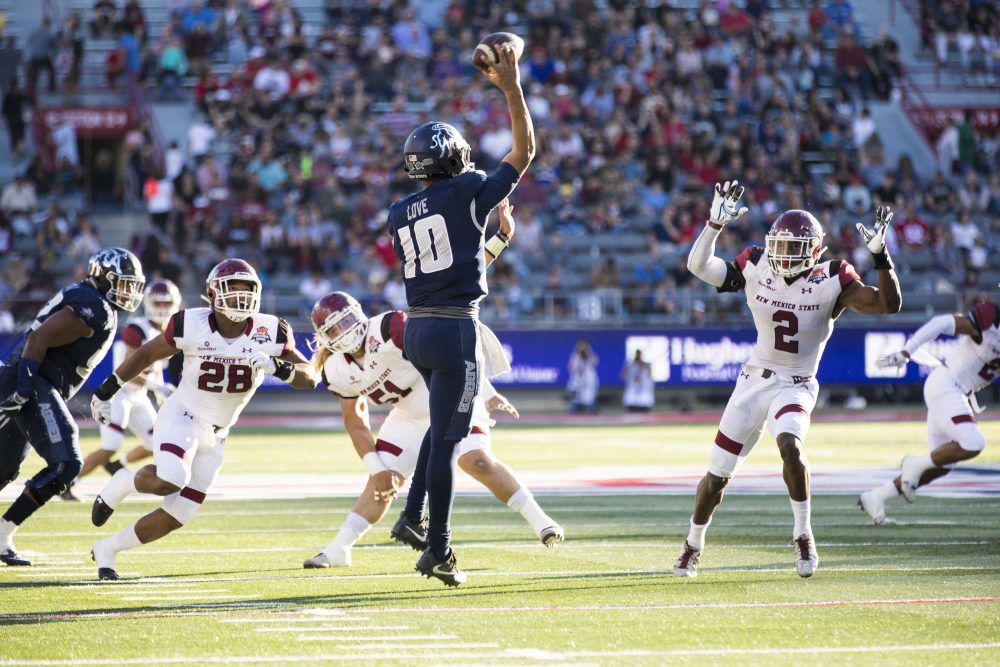
Dec. 29, 2017
Bronco Stadium (Boise, ID)
Utah State (6-6) — 20
New Mexico State (6-6) — 26 (OT)
Nearly 21,000 days and 37 regular season matchups after their first meeting in the 1960 Sun Bowl, the Aggies and Aggies met again in a bowl game.
Jordan Love, the third freshman to start a bowl in four outings for Utah State, set a then-career high and USU bowl record with 44 pass attempts. Unfortunately, not one managed to find its mark in the end zone as. Just like the 2015 Potato Bowl, the Aggies’ offense struggled to finish on offense.
It was ugly for both sides on offense. There were four turnovers, 20 punts and just two offensive touchdowns in regulation between the two teams.
Utah State got the worse end of failed chances. They fumbled (and lost) the ball at the one yard line and the usually reliable kicker Dominik Eberle missed four field goals. Prior to that game, the only time Eberle had missed the mark on a field goal that season was when he had a kick blocked against BYU.
Had the Aggies capitalized on just one of those four missed scoring opportunities in regulation, they might have avoided overtime, a fifth missed scoring chance (Eberle’s fourth miss came in OT) and giving up a game-winning 21-yard Larry Rose III touchdown run.
New Mexico Bowl (2018)
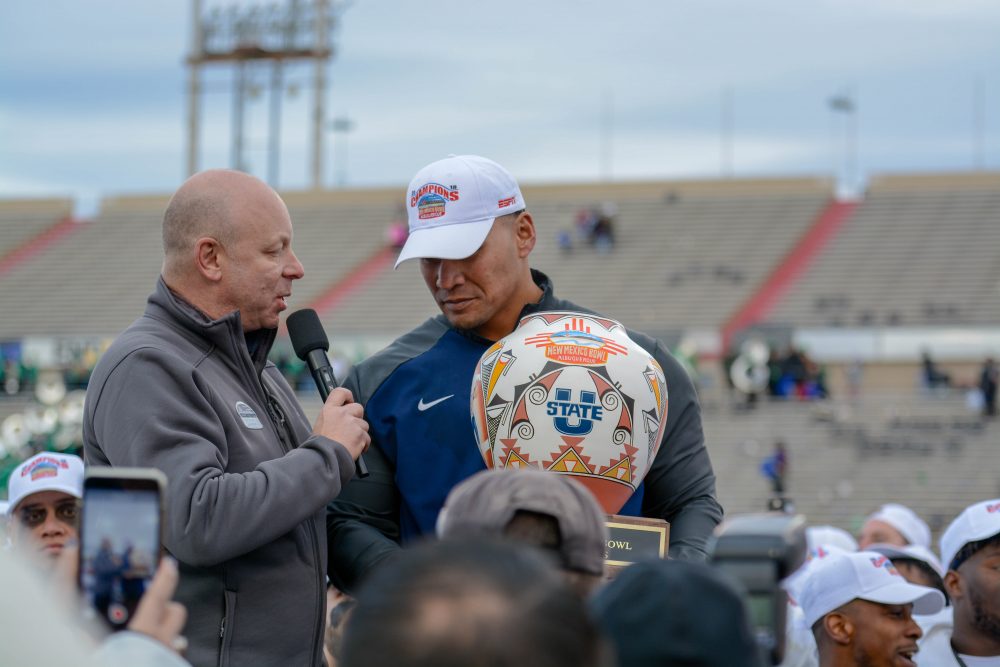
Frank Maile holds the New Mexico Bowl Game trophy after USU wins with a final score of 52-13.
Dec. 15, 2018
Dreamstyle Stadium (Albuquerque, NM)
Utah State (11-1) — 52
North Texas (9-3) — 13
After coming up short in its quest to win a Mountain West title, Utah State took its record-setting offense to New Mexico to face a formidable foe in North Texas. Head coach Matt Wells made an early departure from the team after accepting the Texas Tech coaching job, leaving interim coach Frank Maile and just three other assistant coaches to lead the team.
Though the Mean Green were a tough opponent, they suffered multiple early losses via injury. Leading wide reciever Rico Bussey Jr., who had 1,017 yards and 12 TDs in the regular season, didn’t suit up and quarterback Mason Fine left the game in the first half with a hamstring injury.
Thanks in part to those injuries, USU’s defense strangled the UNT offense, forcing four turnovers. All of those were interceptions. Two were caught by eventual the Defensive MVP of the night, D.J. Williams, and the other two were made by Aaron Wade and David Woodward.
Utah State’s offense found just as much success as the defense. Jordan Love set two USU bowl records with 359 passing yards and four passing TDs. Love also ran for one touchdown.
Gerold Bright and Darwin Thompson dearly became the first running back duo since Robert Turbin and Michael Smith to both rush for 100 yards. Bright got there with 103, including a 26-yard touchdown, but Thompson came up just shy with “only” 93 yards in his last collegiate game.

